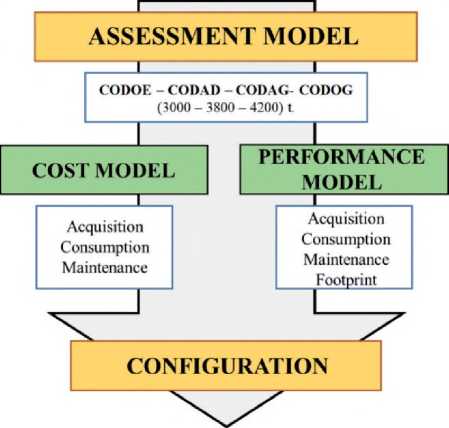
Ship Science & Technology - Vol. 17 - n.° 34 - (45-56) January 2024 - Cartagena (Colombia)
DOI: https://doi.org/10.25043/19098642.249
Daniel Álvarez Berdugo 1
Miguel A. Romero A. 2
Juan E. Cruz 3
1 Technical Section PES Program - Navy Republic of Colombia. Bogota, Colombia. Email: daniel.alvarez.ber@armada.mil.co
2 Technical Section PES Program - Navy Republic of Colombia. Bogota, Colombia. Email: miguel.romero@armada.mil.co
3 Technical Section PES Program - Navy Republic of Colombia. Bogota, Colombia. Email: juan.cruz@armada.mil.co
Date Received: December 5th, 2022 - Fecha de recepción: 5 de diciembre de 2022
Date Accepted: March 1st, 2023 - Fecha de aceptación: 1 de marzo de 2023
History it has become evident that the military industry and its thriving action has generated change and development in different areas, and it is to be expected that a project as ambitious as the Strategic Surface Platform - PES focuses on the impact that internal combustion systems can generate in the design, therefore an evaluation model is developed for the selection of the propulsion system of the platform, which was based on the life cycle cost and performance of the main mechanical equipment, providing an additional tool for decision making. The cost side was estimated by breaking down the ROM (Rough Order of Magnitude) acquisition costs, maintenance costs and fuel and lubricant consumption costs, which leaves the performance side evaluated under the technical characteristics, considering the criteria of performance, reliability, delivered power and installation footprint; without leaving aside the mandatory requirements such as IMO TIER III gas emissions, reduction of the acoustic signature and the use of redundancy.
Keywords: Maritime pollution; Greenhouse gases; Cost Effectiveness; Energy Saving; Propulsion System.
A través de la historia se ha hecho evidente cómo la industria militar y su pujante accionar ha generado cambio y desarrollo en las diferentes áreas, y es de esperar que un proyecto tan ambicioso como lo es la Plataforma Estratégica de Superficie - PES se enfoque en el impacto que los sistemas de combustión interna pueden generar en el diseño, por lo anterior se desarrolla un modelo de evaluación para la selección del sistema de propulsión de la plataforma, el cual fue basado en el costo del ciclo de vida y el desempeño de los equipos mecánicos principales, brindando una herramienta adicional para la toma de decisiones. La arista del costo se estimó desglosando los costos de adquisición del tipo ROM (Rough Order of Magnitude), costos de mantenimiento y costos de consumo de combustible y lubricante, lo que deja la arista de desempeño evaluada bajo las características técnicas, considerando los criterios de rendimiento, confiabilidad, potencia entregada y huella de instalación; sin dejar a un lado los requisitos de obligatorio cumplimiento como lo son las emisiones de gases IMO TIER III, la reducción de la firma acústica y el empleo de la redundancia.
Palabras claves: Contaminación marítima; Gases de efecto invernadero; Rentabilidad; Ahorro de energía; Sistema de propulsión.
The maritime industry has received a growing demand in the variation of propulsion system configurations, which are not only limited to seeking significant fuel savings, but also focus their efforts on the optimization of environmental and performance variables, which directly and indirectly affect the development of the logistics chain to produce vessels. The military industry is no stranger to these processes, and, through the navies of the different nations, it is also taking part in these requirements, generating greater demands on each of the companies involved.
In this way, the increase in standards and regulations, force to establish strict acceptance criteria on the different configurations of propulsion systems traditionally used in the maritime industry, criteria such as reduction in emission percentages, variation in speed ranges, multi-mission units, reduction in crews, technical requirements, among others.
On the other hand, facing the challenges caused by the scarcity of fossil fuels and the problematic of its effects on global warming, as mentioned by Zhu (2018), for the design in the process of propulsion system optimization, international regulations have been promulgated, such as the energy efficiency design index (EEDI) and the ship energy efficiency management plan (SEEMP), aimed at reducing the growth rate of fuel consumption and greenhouse gas (GHG) emissions in the shipbuilding sector (Zhu et al., 2018). Thus, different authors have shown the need to develop energy efficient ships, working in accordance with environmental regulations and giving rise to proposals for hybrid propulsion and generation designs and configurations (Geertsma, Negenborn, et al., 2017; Geertsma, Vollbrandt, et al., 2017).
Therefore, and in summary, the objectives achieved in the development of this work include:
The structure of the article begins with a description of the decision-making model and the approaches available in the literature (research background), followed by a description of the life cycle cost and performance model, based on the analysis of four different propulsion system arrangements currently available in the market. Finally, based on the results obtained, conclusions are proposed showing the arrangement selected for the PES project, which best fits the established design parameters.
It is clear that there is a progressive trend towards partial or full electric propulsion, examples of which have been the British Navy's Type 23 ASW frigate, the German Navy's F125, the Spanish Navy's Fl 10, the Italian and French Navy's FREMM, the Republic of Korea Navy's FFX-II frigate, and the Finnish Navy's SQ2020 frigate programs (Ohmayer, 2012; Reyal Naiy U.K., n.d.; Silatan et al., 2014).
Despite this trend towards hybrid systems, making the decision to turn to their implementation becomes a long and tedious process that includes many angles (from the design phase to the retirement phase), even more so, knowing that the decisions made during the early design phases will generate a significant impact throughout the entire life cycle. This is why this approach has become a design tool for strategic decision making throughout the entire life cycle (Zhu et al., 2018).
In this sense, the evaluation model for the selection of the ESP propulsion system, shown in Fig. 1, was based on the parameters established in Table 1, considering the cost in the projected 30-year life cycle, associating the costs of acquisition, maintenance and operation of the equipment, also considering the cost of fuel and lubricant, as well as the performance of each configuration, evaluating the performance, reliability, power and footprint.
Fig. 1. Model selection propulsion system.
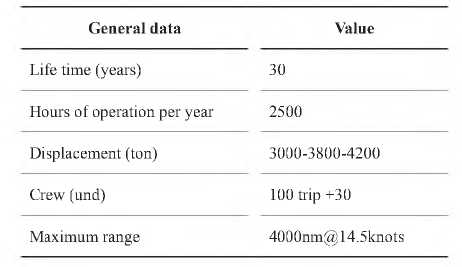
The development of a decision making model for the selection of the propulsion system became an essential part of the development process of the Strategic Surface Platform; managing to meet the requirements of speed and power of the ship, where undoubtedly, the Colombian Navy has considered each of the variables commonly evaluated in the maritime industry, such as rising costs or scarcity of fossil fuels, which lead to rethink the traditional systems or arrangements installed on warships, making these decisions are oriented towards more efficient solutions. However, the challenges for this process increase considering the additional demands, such as the speed-power profiles at which ships usually work, variability in electrical power ranges, and even the lack of resources for asset maintenance during the life cycle, which make the optimization process even more complex under this scenario.
Based on this, an evaluation was made of the propulsion system configurations existing in the market used in modern platforms, such as CODOE, CODAD, CODAG and CODOG, including the recommended operating variables for each gear at different platform speeds, analyzing acquisition costs, maintenance costs, dimensions, weights, technical specifications, and fuel consumption.
For the purposes of this analysis, propulsion configurations were selected for three types of vessels with expected displacements of 3000, 3800 and 4200 tons, considering high power diesel engines to supply each of these requirements, evaluating seven (07) possible speed ranges for each of the selected displacements as shown in Table 2.
Table 2. Power required for each array.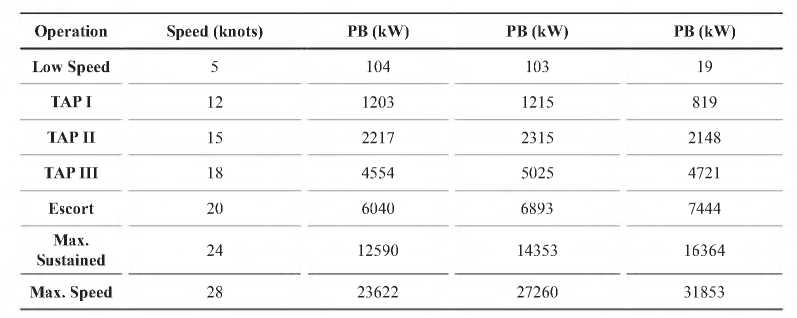
Likewise, using the MaxSurf toolTM in its Resistance module, the statistical methodology for displacement vessels established by Fung and Holtrop (Caputo, 2010; Holtrcp & Mermen, 1977) was applied. (Caputo, 2010; Holtrcp & Mennen, 1977). The statistical methodology for displacement vessels established by Fung and Holtrop (Caputo, 2010; Holtrcp & Mennen, 1977) was applied to obtain the predictions of drag and effective power, as well as the power to the brake using a total efficiency margin of 50%.
Fig. 2. Brake power curve and % operating time as a function of speed profile.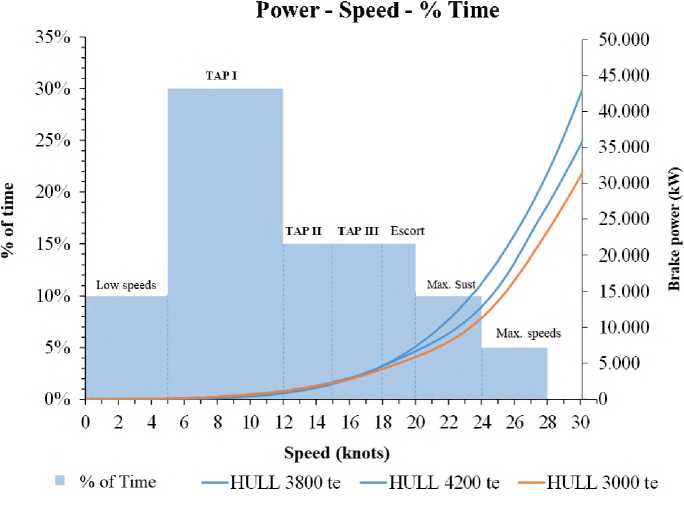
In this configuration, four engines satisfy the different speeds of the operational profile, requiring four diesel engines (MD) for maximum speed and two engines (diesel or electric) (G) for transit and patrol speeds, analyzing five different engine arrangements and brands.
For this configuration, four diesel engines satisfy the different speeds of the operational profile, requiring all four for maximum speed and two engines for transit and patrol speeds, also analyzing five different engine arrangements and makes.
In this case, the gas turbine (TG) provides the power required to replace the engines, however, the gearbox (ER) becomes a critical element, since failure would leave the vessel without propulsion.
Fig. 3. CODOE Configuration Representation.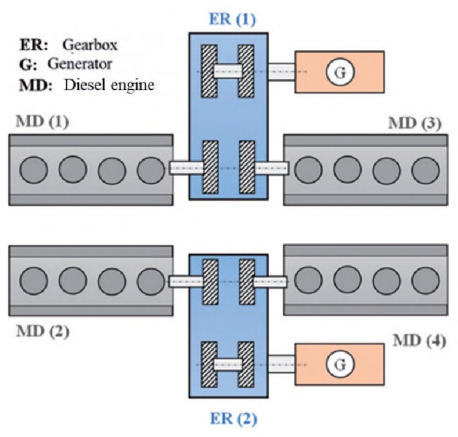
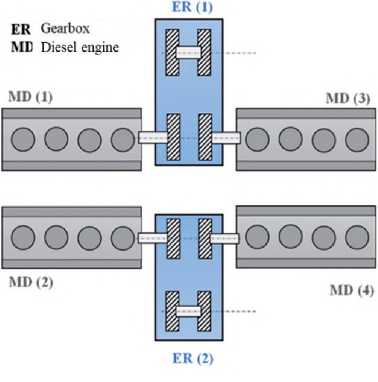
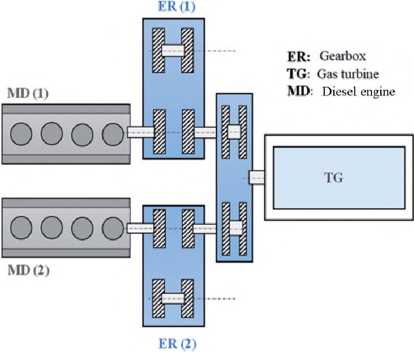
The distribution of equipment for this arrangement is the same as in CODAG, the difference lies in the requirements of the turbine to reach maximum speed without the use of diesel engines, additionally the box will have the mechanism to clutch or not the diesel engines. Eleven different engine arrangements and brands were also analyzed.
In this sense, a total of 30 different arrangements were evaluated for each of the proposed vessels of 3000, 3800 and 4200 tons, as shown in Table 3.
Table 3. Configurations analyzed by displacement.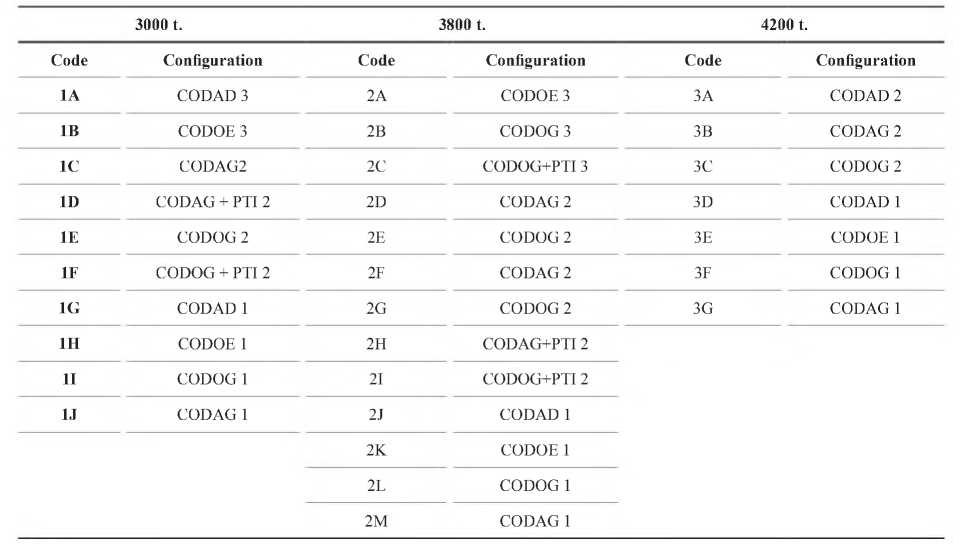
The model estimated the relative costs of acquisition and operation in each proposed configuration, through the analysis of the cost of acquisition of type (ROM), maintenance and consumption of fuel and lubricant, determined for each of the stipulated configurations (to facilitate the compression of the process, the results obtained for the displacement of 3000 t. are presented (see Fig. 6), as follows:
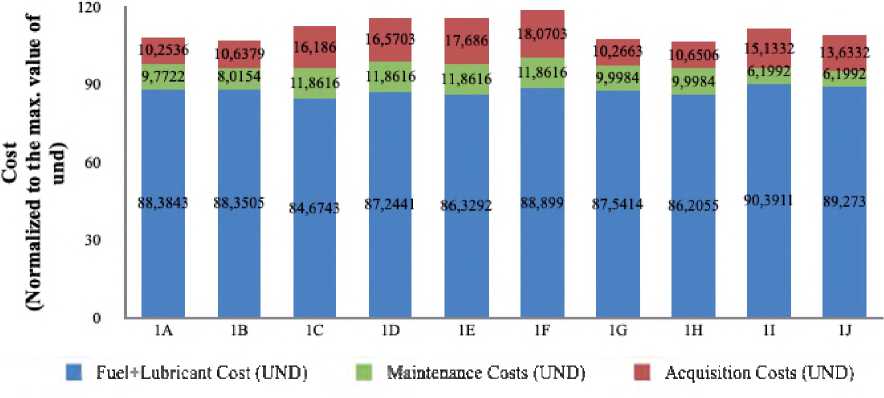
To evaluate the technical characteristics of the propulsion configurations and quantitatively compare the different proposals, the performance model was developed using the analytical hierarchical process (AHP) (see Fig. 7), which allowed establishing levels according to each configuration, with weightings in the criteria and subcriteria established at each level, to give greater specificity to the determination of performance in the situation analyzed.
Fig. 7. Tree structure - evaluation criteria.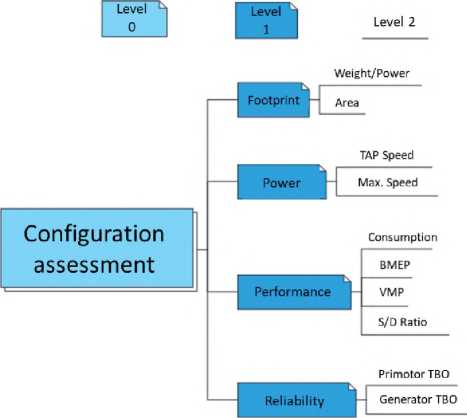
For the performance model is analyzed (see Fig. 8.):
Fig. 8. Reference image of the Performance Result - 3000 t displacement.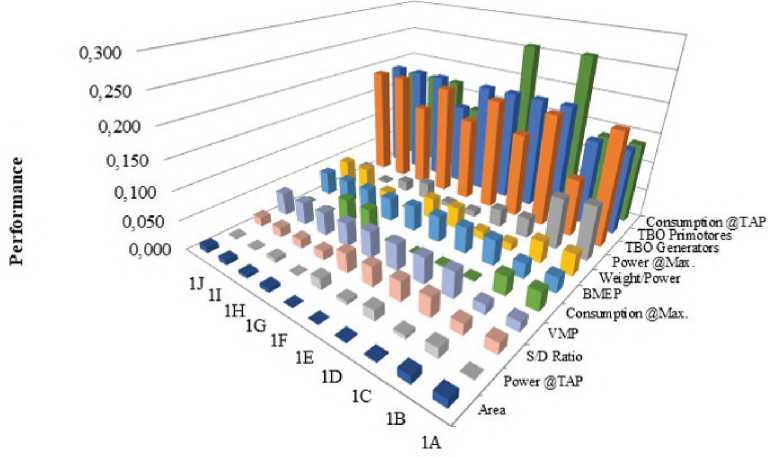
Likewise, using the matrix of pairwise comparisons (AHP methodology) of technical characteristics of each configuration evaluated by the Corporación de Ciencia y Tecnología para el Desarrollo de la Industria Naval Marítima y Fluvial - COTECMAR and the panel of experts of the Colombian Navy - ARC, the weights of each criterion were determined, to subsequently evaluate the alternatives according to the available information, the latter using the ExpertChoice softwareTM . In this way, each level, criterion and subcriterion was weighted through curves (linear, linear decreasing, logarithmic, logarithmic decreasing, exponential, exponential decreasing, sigmoidal and sigmoidal decreasing), according to the choice of the panel of experts, based on the real needs of the Colombian Navy and that which best fits the requirements of Table 4.
Table 4. Curves by criteria and levels.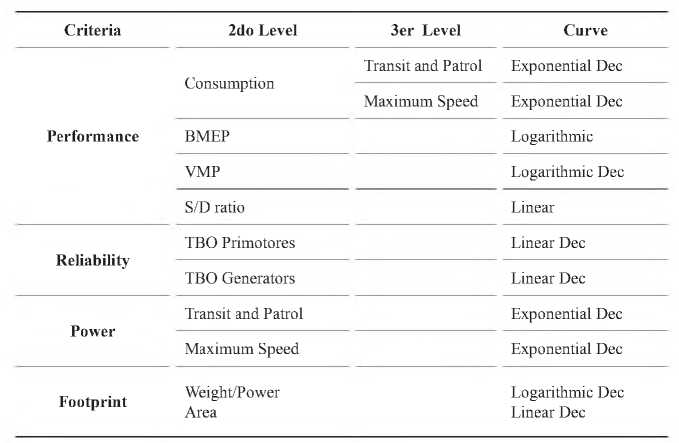
From this analysis and the respective weightings for each level, the total performance shown in Fig. 9 is obtained.
Fig. 9. Reference image of Comparison of Alternatives - 3000 t displacement.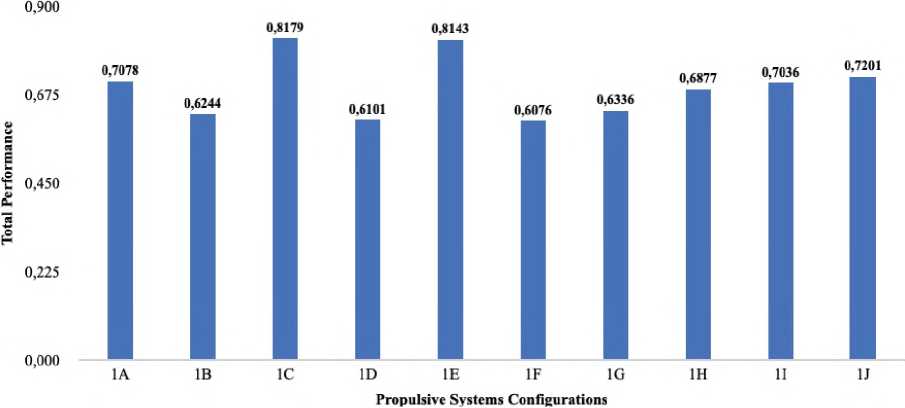
The results of the cost and performance models were analyzed and determined for each arrangement and for each displacement, as follows:
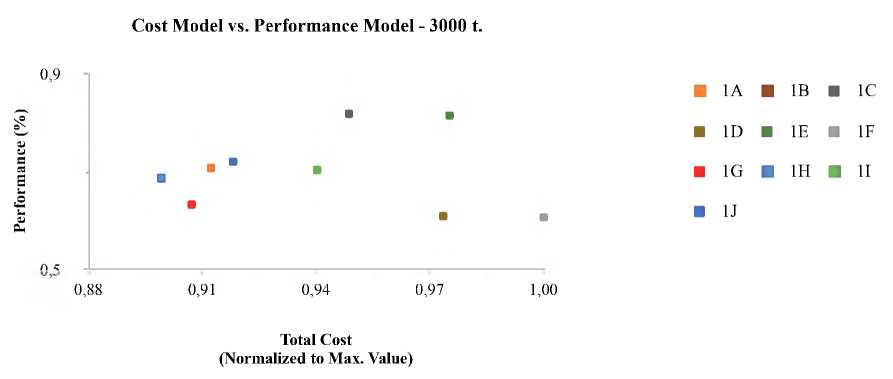
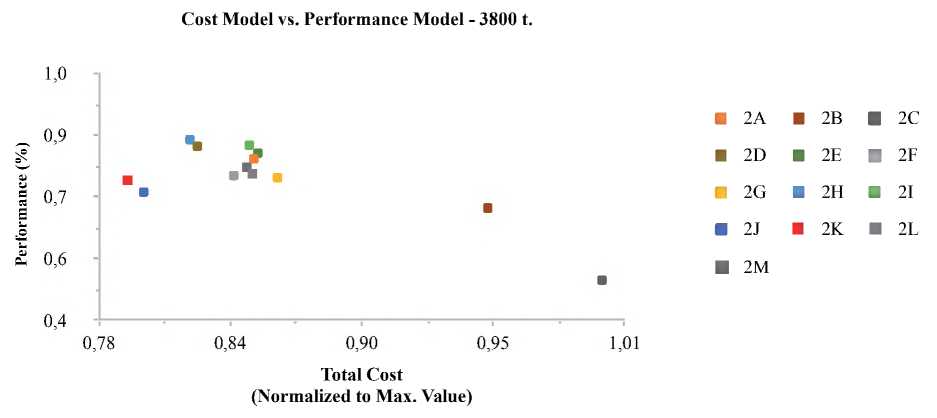
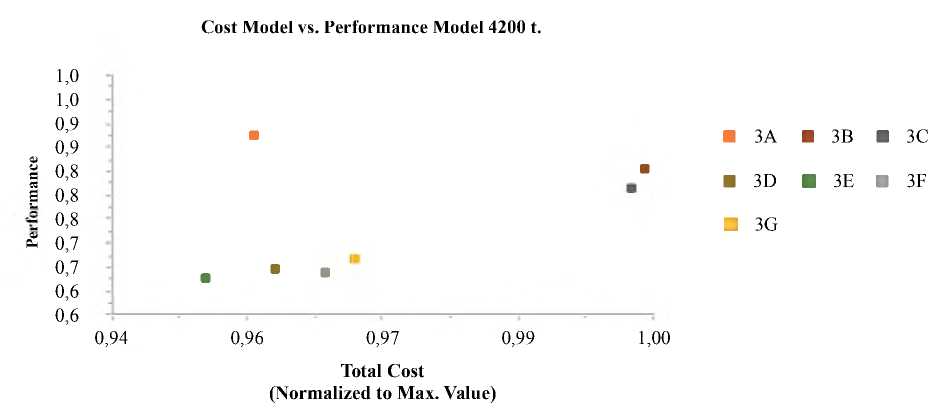
Regarding costs, in general the CODAG and CODOG configurations represent a low maintenance cost related to the low frequency required for the execution of major repairs (Overhaul) during their useful life, however, the overall cost of the gas configuration is high, emphasizing the initial acquisition cost compared to the CODAD and CODOE configurations. On the other hand, when analyzing fuel and lubricant consumption, there is no marked trend that depends on the type of arrangement; however, its impact is directly related to the use profile, engine brand, among others.
Emission control: is considered as a vital variable within this analysis, which is aligned with the compliance of the International Convention for the Prevention of Pollution from Ships (MARPOL) -Annex IV in the TIER III level required for ships built after 2016, in this sense, based on the results presented, aligned with what has been exposed by (Aakko-Saksa et al., 2023; Lindstad & Sandaas, 2016) the percentage of carbons, carbon dioxide, nitrous oxides (NOx), sulfur oxides (SOx), among others, rise mainly at low speeds and operating powers.
The above leads us to the operation profile analyzed (see Fig. 2) which will maintain low speeds 10% and speeds below 18 knots 70% of the time, this urges us to evaluate efficient alternatives that allow us to mitigate or reduce emissions levels, this is how the implementation of a hybrid system, in alternative combinations CODOE - CODAD, in this case one of dieselelectric and diesel engines (CODELAD), shows significant advantages that provide solutions to some problems raised by optimizing the operation of the machinery in each of the profiles according to the operational need and thus ensuring the proper operation in controlled environmental areas, without impacting their performance and seeking the best cost-benefit ratio (Ammar & Seddiek). (Ammar & Seddiek, 2021).
On the other hand, (Silatan et al., 2014) mentions that the high efficiency of hybrid systems (due to the variation of the configuration adapted to the speed profile) leads to low fuel consumption and causes a reduction of environmental pollution, achieving lower emissions of 4.3 gr/kwh of NOx and less than 1% of Sox, required to operate in the Emission Control Zone, contributing to regulatory compliance for the units where it is implemented.
Signatures: are not considered as a design parameter in the present work, even so, it is sought to maintain directives in Grade A equipment assemblies that classify propulsion equipment as necessary equipment for the safety and combat capability of the ship, in this way a CODELAD configuration presents significant advantages, such as the reduction of acoustic, infrared and electromagnetic signature, up to TAP II speeds (see Table 2), where Diesel-Electric propulsion is used (Barias & Azmi Ozscysal, 2001). (Barias & Azmi Ozscysal, 2001).
Redundancy: has been considered in the design of the vessels as one of the parameters that has been handled as a restriction, where it is necessary the ability to maintain the vessel's operations even after losing an engine room. This study considers the distribution of the electrical load in four (04) generators and that they comply with the N-l restriction, i.e. that due to redundancy and separation, two (02) generators are located in two (02) engine rooms separated by at least one watertight bulkhead and that when losing one of these rooms, the remaining generators in operation are capable of satisfying the vital loads of the entire vessel.
The analysis presented in this paper is an extract of the activities developed by the ARC and COTECMAR work team, who have generated several tools, among them, the decision-making model for the selection of the propulsion system of the Strategic Surface Platform, which represents one of the steps that the program has fulfilled for the selection and validation of the platform systems, and through which it can be concluded:
AAKKO-SAKSA, P. T., LEHTORANTA, K., KUITTINEN, N., JÄRVINEN, A., JALKANEN, J. P., JOHNSON, K., JUNG, H., NTZIACHRISTOS, L., GAGNE, S., TAKAHASHI, C„ KARJALAINEN, P., RÖNKKÖ, T., & TIMONEN, H. (2023). Reduction in greenhouse gas and other emissions from ship engines: Current trends and future options. In Progress in Energy and Combustion Science (Vol. 94). Elsevier Ltd. https://doi.org/10.1016/j.pecs.2022.101055 .
AMMAR, N. R., & SEDDIEK, I. S. (2021). Evaluation of the environmental and economic impacts of electric propulsion systems onboard ships: case study passenger vessel. Environmental Science and Pollution Research, 28(28), 37851-37866. https://doi.org/10.1007/sll356-021-13271-4
BARLAS, B., & AZMI OZSOYSAL, O. (2001). The diesel-electric hybrid propulsion systems for Turskish frigates. https://www.researchgate.net/publication/266204021
CAPUTO, R. J. (2010). Impacts of Reducing Shipboard NOx and SOx Emissions on Vessel Performance. Massachusetts Institute of Technology.
GEERTSMA, R., NEGENBORN, R. R., VISSER, K., & HOPMAN, J. J. (2017). Design and control of hybrid power and propulsion systems for smart ships: A review of developments. In Applied Energy (Vol. I94, pp. 30-54). Elsevier Ltd. https://doiorg/10.1016/j.apenergy.2017.02.060 .
GEERTSMA, R., VOLLBRANDT, J., NEGENBORN, R., VISSER, K„ & HOPMAN, H. (2017). A quantitative comparison of hybrid diesel-electricand gasturbine-electric propulsion for future frigates. Defence Materiel Organisation, 451-458.
HOLTROP, J., & MENNEN, G. G. (1977). An approximate power prediction method. 166170.
LINDSTAD, H. E., & SANDAAS, I. (2016). Emission and fuel reduction for offshore support vessels through hybrid technology. Journal of Ship Production and Design, 32(4), 195-205. https://doi.org/10.5957/JSPD.32.4.150006
MORALES E., O., SILVA, A., ZARATE, F., & ARMADA DE COLOMBIA (2016a). Technical Concept Evaluation of configurations for the ESP propulsion system.
MORALES E., O., SILVA, A., ZARATE, F., & ARMADA DE COLOMBIA (2016b). Report Development of evaluation model for selection of the propulsion system of the Strategic Surface Platform - PES.
OHMAYER, H. F. (2012). Propulsion System Choices for modern Naval Vessels.
Royal Navy U.K. (n.d.). DUKE CLASS TYPE 23 FRIGATE. Retrieved January 22, 2023, from https://www.royalnavy.mod.uk/the-equipment/ships/frigates/duke-class
SILATAN, S., EDALAT, P., & RAHIMI, M. (2014). Hybrid Propulsion System For New Generation Of Ships. www.SID.ir
ZHU, J., CHEN, L., WANG, B., & XIA, L. (2018). Optimal design of a hybrid electric propulsive system for an anchor handling tug supply vessel. Applied Energy, 226, 423-436. https://doi.org/10.1016/j.apenergy.2018.05.131.